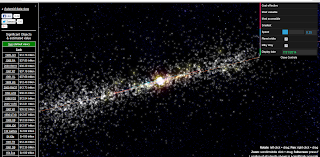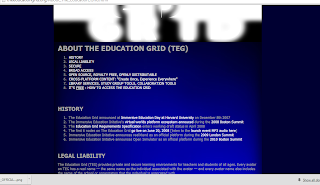The following experiments failed using Firefox rather than Chrome:
Find Your Way to Oz- Says it was designed with Chrome in mind, allows me to attempt to launch, crashed my Firefox browser
Just a Reflektor - Only showed the homepage
The following worked:
Depth of Field
PlayMaps Cube
WebGL Terrain
Indras Net
Saint Jean Cathedral of Lyon
Water/Ocean
Squishy Earth
WebGL Attractors Trip
WebGL Bookcase
Digital Landscapes
The Hobbit
Car Visualizer
Spacerun 3D II
FaceTron
100,000 Stars
Interactive 3D Skeleton
Are You Being Watched?
Spherical Normal Mapping
Simple Maze Game
Asterank
Parallax
Thursday, November 21, 2013
WebGL Chrome Experiments using Google's Chrome Browser
Parallax
This experiment is stationary objects that slightly move. It recommends to open it with a tablet or phone because tilting would enhance the experience and the objects would move.
Asterank
This experiments is a visualization of the solar system. Using the drag & click method you can move it around to see the system from different angles and see different stars.
Simple Maze Game
Using the arrow/WASD keys and the drag & click method, this experiment takes you through a maze.
Wednesday, November 20, 2013
Cloud Party House Build Final
These are screenshots of my class and myself building a house as a group project in a virtual reality world. It is a final exercise from the Immersive Education course that I am taking at Boston College. The course is called Discovering Computer Graphics. For details, visit the immersive BC portal at http://ImmersiveEducation.org/@/bc
Thursday, November 14, 2013
Education Grid
EducationGrid is a free program online that was designed to be an educational tool for all ages. Each user must use verified credentials and their own name as a username. It was announced in 2007. It can be very customizable based on the user. There is a small bit of controversy with having this virtual education environment because of what younger students may encounter during their time online. It is open source and you can use anything created on this platform on any other platform.
FINAL 5c: MY CUSTOMIZED JAVA GAME
This is a small video game that was called Trick the Turtle that I created in a program called Greenfoot using a tutorial from http://blogs.kent.ac.uk/mik/category/joy-of-code/page/2/. I changed the images to an image of myself and an image provided by my instructor. Greenfoot is a program that creates scenarios or games with Javascript. It is a midterm (or final, if it's a final) exercise from the Immersive Education course that I am taking at Boston College. The course is called Discovering Computer Graphics. For details, visit the immersive BC portal at http://ImmersiveEducation.org/@/bc.
progress screenshot:
FINAL 5b: Greenfoot Lettuce and Snake
This is a small video game called Trick the Turtle that I created in a program called Greenfoot using a tutorial from http://blogs.kent.ac.uk/mik/category/joy-of-code/page/2/. It is a program that creates scenarios or games with Javascript. It is a midterm (or final, if it's a final) exercise from the Immersive Education course that I am taking at Boston College. The course is called Discovering Computer Graphics. For details, visit the immersive BC portal at http://ImmersiveEducation.org/@/bc.
Progress Screenshots:
FINAL 5a: Greenfoot JoC #4 Finally some code!
This is a small video game called Trick the Turtle that I created in a program called Greenfoot using a tutorial from http://blogs.kent.ac.uk/mik/category/joy-of-code/page/2/. It is a program that creates scenarios or games with Javascript. It is a midterm (or final, if it's a final) exercise from the Immersive Education course that I am taking at Boston College. The course is called Discovering Computer Graphics. For details, visit the immersive BC portal at http://ImmersiveEducation.org/@/bc.
progress screenshots:
Thursday, November 7, 2013
Monocular Depth Cues
The following photos are 6 screenshots of monocular depth cues, which are different ways used in 2D creations (such as on the computer/web and in paintings) that give the impression of depth (distance) making the image appear the be in 3D. They are part of a final exercise from the Immersive Education course that I am taking at Boston College. The course is called Discovering Computer Graphics. For details, visit the immersive BC portal at http://ImmersiveEducation.org/@/bc. |
| In this image, some of the skulls appear smaller & less clear/detailed, giving the impression that they are farther away than the larger clearer skulls. This is an example of atmospheric perspective (by being less clear and less detailed) and also an example of size differences. |
 |
| In this image, the stairs that are circled seem to be very small & dense, making them appear to be far away. This is an example of texture density. |
 |
| In the third image, the trees in the background are smaller, which makes them look farther away and the bigger trees look closer. This is an example of size differences. |
 |
| In this image, the lines on either side of the docks seem to get narrower, giving us the impression that there is distance. This is an example of linear perspective. |
 |
| In the sixth image, the table blocks part of the "404 not found" structure, making it look like the table is closer. This is an example of occlusion. |
MakeHuman Avatar Final
This is an avatar I created using the MakeHuman program. It is a program that helps a person create high resolution avatars. It is a final exercise from the Immersive Education course that I am taking at Boston College. The course is called Discovering Computer Graphics. For details, visit the immersive BC portal at http://ImmersiveEducation.org/@/bc
progress shots:
WebGL
WebGL (Web Graphics Library) is a program created by Vladimir Vukićević with the Khronos Group. It is a program used to create 2D and 3D graphics. It works with most browsers and doesn't require any plug-ins. It is based on Javascript, but can also be used with HTML. Google Maps is an application created with an early version on this application.
Cloud Party Building
In this assignment, I built something in the virtual world called Cloud Party. I built a small building and decorated the inside of it using some pre-made materials. It seems like building in OSgrid was a little more advanced because there were a lot more pre-made shapes, whereas Cloud Party only had blocks as a shape (from what I could see) and all the pre-made materials were actual objects.
Wednesday, November 6, 2013
Class 9; Assignment 5
In this week's class, we experimented with creating 3D objects in a virtual world. We had to create a Rocket Ship. My rocket ship was created using very basic shapes and changing the size and positions.
progress shots:
Subscribe to:
Comments (Atom)













































